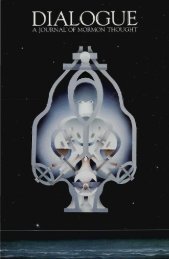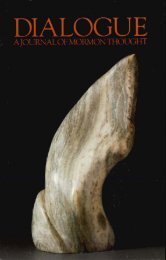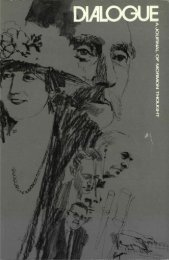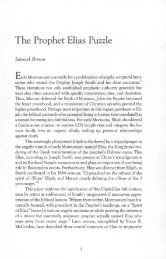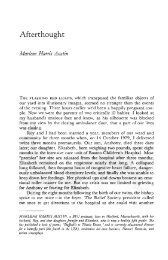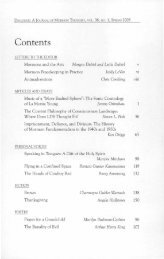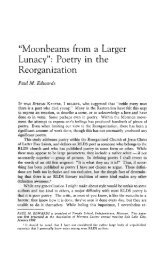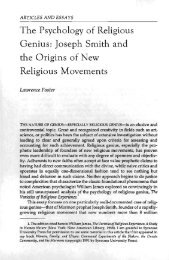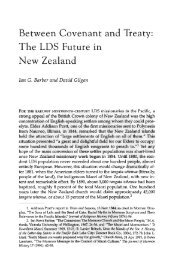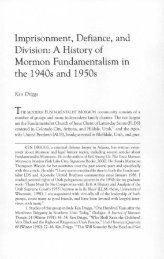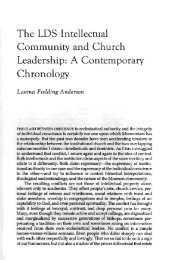Dialogue, Volume 25, Number 2 - Dialogue – A Journal of Mormon ...
Dialogue, Volume 25, Number 2 - Dialogue – A Journal of Mormon ...
Dialogue, Volume 25, Number 2 - Dialogue – A Journal of Mormon ...
You also want an ePaper? Increase the reach of your titles
YUMPU automatically turns print PDFs into web optimized ePapers that Google loves.
Knowlton: <strong>Mormon</strong>ism in Latin America 51<br />
thing we have to <strong>of</strong>fer? How do Latin American <strong>Mormon</strong>s understand<br />
belief and faith and their relationship to deity, society, and salvation?<br />
To answer these difficult questions, we must approach Latin American<br />
<strong>Mormon</strong>ism on its own terms, rather than from the perspective <strong>of</strong><br />
Anglo-American, Wasatch-front <strong>Mormon</strong>ism. Because Latin Americans<br />
generally use the rituals and words within the Church that we<br />
have taught them, it is easy to assume that they attach the same meaning<br />
to them. This is not necessarily the case. For example, an Aymara<br />
Indian may say "nay kritwa," —I believe — based on the loan word<br />
"Kriyifia" from the Spanish "creer." Yet because the word and concept<br />
<strong>of</strong> belief does not exist in the Aymara language, this expression may<br />
simply mean, "I am a Protestant/<strong>Mormon</strong>," rather than saying anything<br />
about a mental relationship with religion (Knowlton 1988, viii).<br />
When we explore the internal dynamics <strong>of</strong> <strong>Mormon</strong>ism in Latin America,<br />
we must be sensitive to the subtleties <strong>of</strong> syncretism and reformulation<br />
in the Latin American social context.<br />
In summary, the Church in Latin America is part <strong>of</strong> a complex<br />
social movement that goes beyond the limited dynamics <strong>of</strong> the Church,<br />
as we commonly understand it. The Church missionary program has<br />
been tremendously successful; in many countries <strong>Mormon</strong>ism is second<br />
only to Catholicism in numbers. Its important presence within<br />
Latin American society has not gone without notice among local scholars.<br />
In Jujuy, Argentina, I met an Argentine anthropologist who is<br />
studying a <strong>Mormon</strong> congregation. In San Juan, the sociology department<br />
has formed a study group to investigate <strong>Mormon</strong>s as well as<br />
other sects springing up there. In Bolivia, and in other countries, the<br />
Catholic church is financing sociological studies <strong>of</strong> the "problem <strong>of</strong> the<br />
sects," and they consider <strong>Mormon</strong>ism a part. <strong>Mormon</strong> scholars should<br />
be involved as well, exchanging insider and outsider perspectives, working<br />
toward an adequate understanding <strong>of</strong> the Church's growth and its<br />
role in struggling Latin societies.<br />
BIBLIOGRAPHY<br />
Aaby, Peter, and Soren Hvalk<strong>of</strong>. Is God an an American?. N.p.: IWGIA, 1981.<br />
Adams, Richard N. Energy and Structure: A Theory <strong>of</strong> Social Power. Austin: University <strong>of</strong><br />
Texas Press, 1975.<br />
. "The Dynamics <strong>of</strong> Societal Diversity: Notes from Nicaragua for a Sociology<br />
<strong>of</strong> Survival." American Ethnologist 8 (February 1981): 1-20.<br />
Albo, Xavier. "Dinamica en la estructura intercomunitaria de Jesus de Machaca."<br />
America Indigena 32 (July-Sept. 1972): 773-810.<br />
. La paradoja aymara, solidaridad y faccionalismo. La Paz, Bolivia: Centro de<br />
Investigacion Promocion del Lapme-Sinado, 1975.



